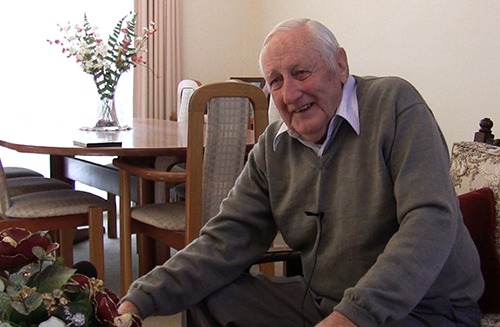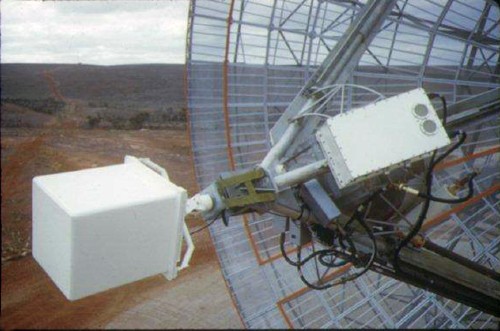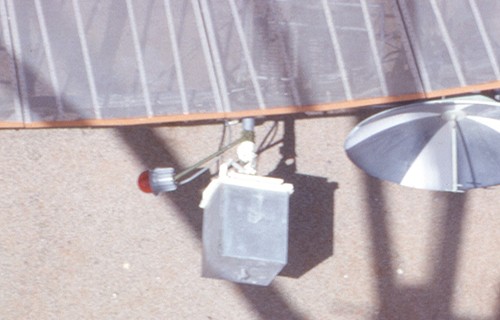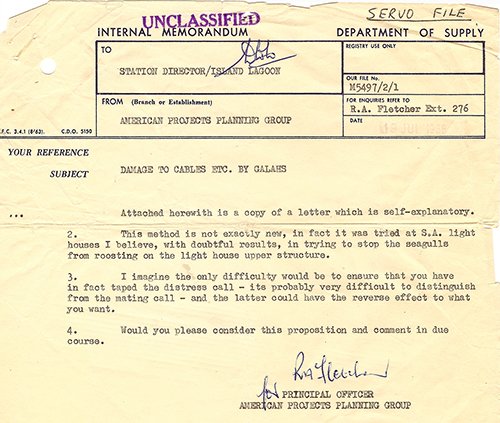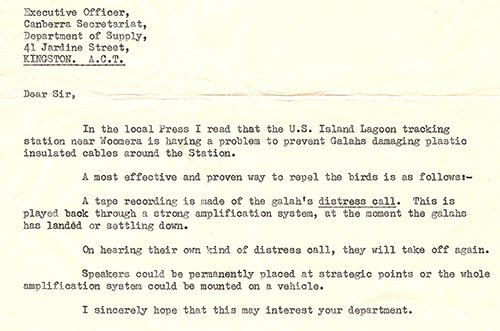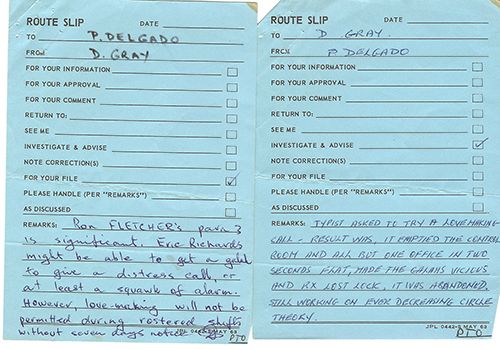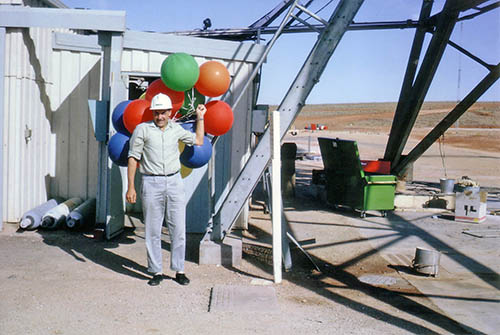Trouble with Galahs at Island Lagoon
Galahs are a very intelligent pink and grey coloured cockatoo found in many parts of Australia.
Not only are they inquisitive, but they can be quite destructive. There are many stories of galahs causing trouble at Island Lagoon.
Don Gray, Senior RF Engineer at DSS-41 from 1963 to 1966, tells one such tale.
(980kb / 2 minute 10 second mp3 file. Extracted from part 1 of this 2010 interview.). |
The styrofoam-covered acquisition-aid, at left, became a target for galahs. In this early photo, it is mounted at the L-Band focus. Photo: Bill Mettyear. |
Just left of centre is the Acquisition Aid, now mounted on the edge of the dish, seen here from the cherry-picker. It’s been fitted with a metal box to protect it from hungry and inquisitive galahs. Photo: Don Gray, January 1964. Scan: Colin Mackellar. |
Ron Fletcher, Principal Officer of the Department of Supply’s American Projects Planning Group, shares a galah-control suggestion with the Island Lagoon Station Director. Scan: Jan Delgado. |
Here’s the suggestion. Scan: Jan Delgado. |
Don Gray, Senior RF Engineer at Island Lagoon, and Pat Delgado exchange memos on the Galah Problem. Scan: Jan Delgado. |
From Pat Delgado –
“The reason why the balloons appeared at the dish was because we asked Adelaide University how best we could discourage the galahs from damaging the cables. They were doing this by rotating round the cables and trepanning them with their beaks.
I was advised to tie the balloons to the vulnerable cables and put a few on the dish rim. The galahs must have thought it was show time or the balloons were some kind of large pregnant parrot. They released some of the balloons by gnawing through the string. They also pecked some and it scared the life out of them when they burst.
There were various suggestions for keeping the galahs off the cables. From using an air gun, poisoning food, banging tin cans, introducing a hawk and someone even suggested rapid reversal of the dish drive hydraulics…. Imagine the stripped gear teeth with that one! I forget what finally happened – I think the galahs went off to pastures new.”
|
Pat Delgado beneath the DSS-41 antenna – holding brightly coloured balloons meant to scare away the galahs. Taken in 1964. Photo: Pat Delgado. |
From John Carter –
“I was a Senior Technical Officer with ‘Supply’ and was one of the operation supervisors at DSS41 (Team A) from late 1963 through 1968. I left when the operation of the station was taken over by the contractors.
A couple of amusing things happened, none disastrous fortunately, during my team’s duty –
The dish stopped during a particular track, and was restarted.
It stopped again and one of the dish drivers went
up to investigate. Around the edge of the dish were a series of bright red emergency
stop buttons, and a galah was observed pecking at one of the buttons and consequently
stopping the dish.
On another occasion, the pre-track calibration checks on the receiver were found to be erratic. One of the station staff was sent up to the test facility to investigate. He found that a large crow was climbing down the legs supporting the feed-horn on the test antenna and peering into the open end of the horn, thereby attenuating the test signal.
The remedy was to fit a loud claxon horn near the test antenna, and to instruct the receiver operator to sound the horn before taking any measurements.
I was sorry to leave the station, and still at Woomera, I was appointed as one of the Departmental supervisors of the Target Aircraft facility on the Range.”
From Tony Dobson –
“I worked at DSS 41, Island Lagoon from 1964 through 1969. I remember a funny episode we had with galahs.
The galahs at one point took a great liking to the Radome that covered the transmitter window at the top of the dish. The Radome was made out of a styrofoam like material which the galahs began to eat. Being a precision piece of equipment the Radome was a very expensive item. The galahs would make short work of it and we were forced to replace it every month or so. NASA, who supplied the Radome, were getting quite perturbed about this due to the expense and the fact that they should have lasted several years without replacement. So they pushed us to find a solution to keep the galahs away.
At the station we tried everything with no luck. We then created a competition across Australia asking for suggestions as to how we could keep galahs away. We were swamped with suggestions and all kinds of foul concoctions to apply to the dish. But alas none of them worked.
However a local hunter sent us in a letter telling us that the only way to keep galahs away was to kill several of them and hang the bodies around the place, and this would guarantee to keep them away.
After much soul searching and a few more Radomes we relented and called in a hunter to do the deed. Several galahs were shot and hung from the perimeter of the dish and surprisingly after a couple of weeks this did the trick.
The galahs left never to return. However it was quite a sight to see this modern high tech marvel festooned with dead galahs. I remember several photos were taken of this, it would be neat to see if anyone has a copy.” (May 2007.)
From Keith Aldworth –
“At Minitrack, we had a large interferometer antenna array, for tracking satellite paths but for telemetry, we had several steerable Yagi arrays. Two of them were driven by electric motors and were quite slow moving.
The SATAN array was driven by hydraulic motors and was extremely fast. The hydraulic fluid was piped to the motors in flexible high pressure hoses (2,000psi). The SATAN was painted white and was quite an impressive structure. It had much higher gain that the other two arrays, which enabled it to receive good signals from quite distant satellites.
One morning when we arrived at work, we were amazed to see the SATAN antenna a bright pink against the blue desert sky.
First reaction was that it had been vandalised during the night but we were soon appraised of the problem.
Galahs had been chewing away at some of the hydraulic hoses and a weakened one had blown out. Hydraulic fluid escaping under that kind of pressure atomises and the antenna had been completely coated. We were without the antenna for some days, as replacement hoses had to be supplied from the U.S.
I wonder if the guilty galah managed to escape with its life. We never did find it. Happy days!”
